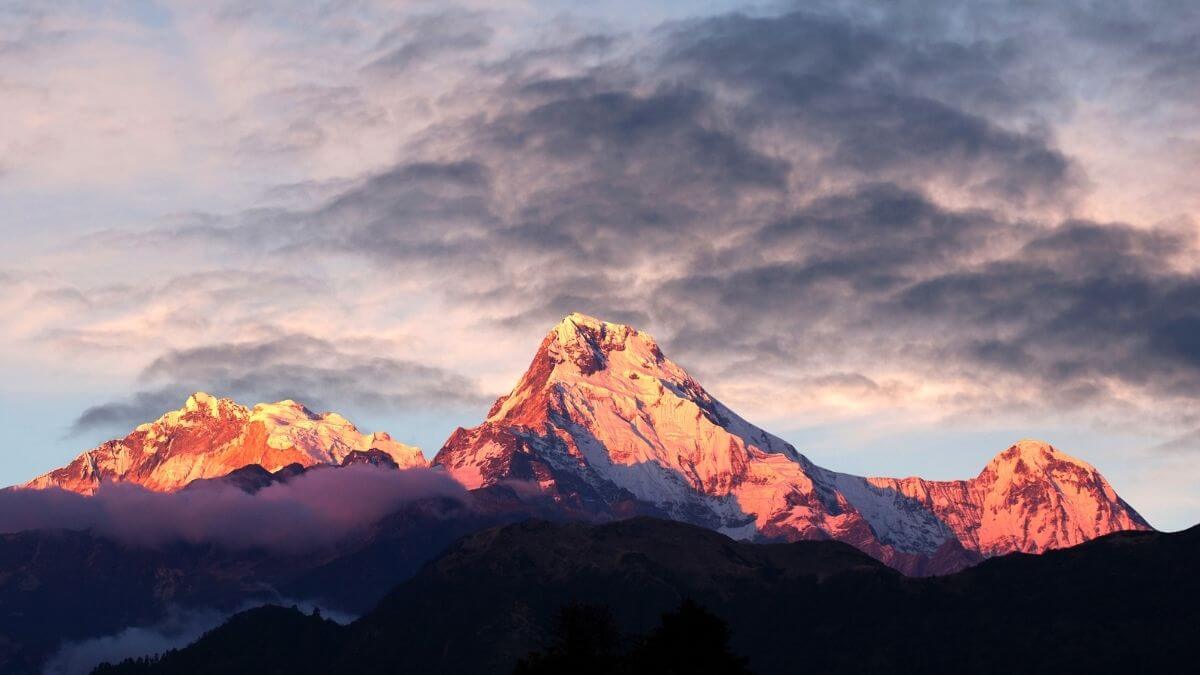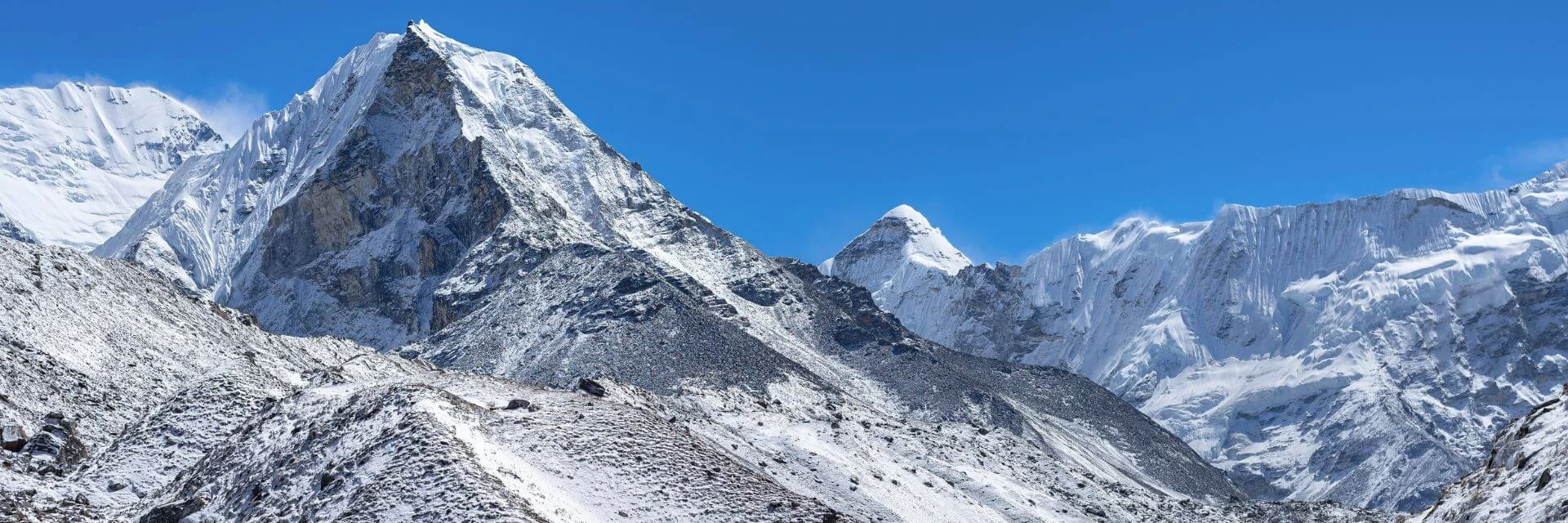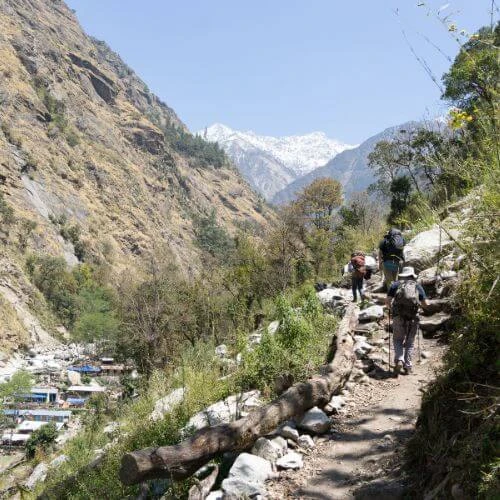Planning an Annapurna Circuit trek is exciting, but understanding the Annapurna Circuit Trek Weather is essential for a safe and enjoyable journey. The weather can change dramatically along the route—from the warm, green villages in the lower regions to the freezing passes like Thorong La. Knowing what to expect ensures that you pick the best season, pack the right gear, and plan for altitude challenges.
In this guide carefully crafted by Abound Holidays, we’ll cover the seasonal overview, month-by-month breakdown, temperature variations by altitude, safety tips, recommended gear, and how to prepare for your trek.
Weather on the Annapurna Circuit: Seasonal Overview
The Annapurna Circuit trek weather experiences four main seasons, each with its own weather patterns and trekking conditions. Here’s a quick look at what to expect.
Spring (March–May)
Spring feels like everything is waking up again. Days slowly get warmer, the skies clear up more often, and the famous rhododendrons start blooming along the mid-altitude trails. Temperatures at lower levels can feel mild, but once you’re heading toward Manang or Thorong La, mornings and nights can still drop below freezing.
The trails get busier as you move into April and May because it’s such a comfortable time to walk. The only downside is that early March may still have leftover snow at higher altitudes, and late May sometimes brings short pre-monsoon showers.
Monsoon / Summer (June–August)
Monsoon completely changes the vibe of the trek. Lower regions get a lot of rain, the air feels heavier, and the paths can be muddy or slippery. Leeches are common in the forested sections below 2,500 meters.
As you climb higher, rainfall slowly decreases, and temperatures get cooler again. Clouds come and go quickly, so views might be limited.
Landslides and roadblocks are more likely during these months, making travel slower. Only experienced trekkers usually choose this season because of the unpredictable conditions.
Autumn (September–November)
Autumn is the most reliable season, and you can feel it right from the start. The skies stay clear for days, the air turns crisp, and everything feels more stable after the monsoon fades away.

Days are pleasant at lower levels, but temperatures get colder as you approach higher villages and the pass. Nights can get below freezing in Manang and even colder near Thorong High Camp.
Winter (December–February)
Winter brings quiet trails, super clear skies, and very cold conditions. Lower villages remain manageable during the day, but as soon as you gain altitude, the temperatures drop sharply. Snow is common above 3,500 meters, and places like Yak Kharka or Thorong Phedi can feel freezing all day long. Thorong La Pass often sees strong winds and heavy snow, which may cause temporary closures.
Ready to plan your adventure? Check out our full Annapurna Circuit Trek guide to get started with routes, tips, and essentials.
Month-by-Month Weather Breakdown
Before diving into the table for the Annapurna Circuit Trek weather by month, here’s a quick note. The Annapurna Circuit trek weather changes a lot from the warm lower villages to the icy high passes, so temperatures always shift with altitude. This table gives you a simple overview of how each month usually feels, what the weather is like, and what to expect on the trail.
Month | Temperature Range | Highlights |
January | –10°C to 5°C | One of the coldest months. Snow is common at high altitudes, and trails can be icy around Thorong La. |
February | –6°C to 8°C | Still winter, but slightly brighter days. High areas stay freezing, though visibility starts improving. |
March | 0°C to 15°C | Start of spring. Lower regions warm up, snow begins melting, and mornings are clearer. |
April | 5°C to 20°C | One of the best months. Stable weather, long, clear days, and blooming rhododendrons. |
May | 10°C to 25°C | Warm lower regions with comfortable trekking. Pre-monsoon clouds may appear in the afternoons. |
June | 15°C to 28°C | Start of monsoon. Humidity rises, rain increases, and lower trails get muddy. |
July | 15°C to 25°C | Peak monsoon. Heavy rain, limited visibility, and higher chances of landslides in the lower sections. |
August | 14°C to 24°C | Still rainy, but conditions are slowly improving. Views start clearing later in the month. |
September | 10°C to 22°C | Monsoon fades. Clean, fresh trails and improving visibility with cooler nights. |
October | 5°C to 16°C | The most stable month. Dry weather, crisp skies, and ideal trekking conditions. |
November | 0°C to 18°C | Clear and dry days. Nights turn very cold above Manang as winter approaches. |
December | –5°C to 12°C | Winter settles in. Snow becomes more likely near the pass, and some high teahouses may close. |
Average Temperatures by Altitude
Temperature changes dramatically as you climb the Annapurna Circuit. Knowing the ranges helps with gear and pacing.
- Low regions (800–2,000 m): Daytime 15 - 25°C; nights 5 -15°C
- Mid-altitude (2,000–3,500 m): Daytime 10 - 20°C; nights 0 - 10°C
- High-altitude (3,500–5,400 m, Thorong La Pass): Daytime 0 - 10°C; nights -10 to -20°C
Tip: Layered clothing is essential. Carry thermal wear, fleece, windproof jackets, and waterproof shells to handle sudden weather changes.
How Weather Affects Trek Planning & Safety
- Altitude Variability: Temperature and precipitation change quickly with elevation. Be prepared for both warm and freezing conditions.
- Pass Crossings (Thorong La): Snow, wind, and freezing temperatures can make crossing dangerous, especially in winter.
- Trail Conditions: Monsoon → muddy trails, slippery paths, leeches; Winter → icy trails, avalanche risk.
- Visibility & Photography: Best clarity is in Autumn and Spring. Monsoon brings cloud cover, limiting mountain views.
- Service Availability: Weather can affect teahouse operations, road access, and supply chains.
Make your trek official and hassle-free. Learn how to get your Annapurna Circuit Trek Permit and start planning today.
What Trekking Gear to Bring Based on Weather
The Annapurna Circuit passes through warm valleys, windy mid-mountain zones, and freezing high passes, so your gear needs to handle sudden changes. Even if the day starts warm, temperatures on Annapurna Circuit trek can drop fast once you climb higher.
Here we have a simple breakdown of what to bring so you stay comfortable and ready for whatever the weather does.
Clothing Layers
- Base layers to stay warm during cold mornings and nights
- Light trekking shirts for the hot lower areas
- Fleece or a warm middle layer for the colder spots
- Windproof and waterproof jacket
- Warm hat, gloves, and neck buff for the cold high places
- Quick-dry trekking pants, plus one warm pair for the pass
Footwear
- Waterproof trekking boots with strong ankle support
- Thick trekking socks for warmth in colder regions
- Extra pairs of socks to keep feet dry
- Gaiters for trekking in winter or during the monsoon
Sleep System
- Sleeping bag rated for sub-zero temperatures
- Sleeping bag liner for extra warmth
- Lightweight travel pillow if you prefer comfort
Don’t forget the right gear! Explore our complete Annapurna Circuit Trek Gear List to pack smart and stay comfortable on the trail.
How to Choose the Best Time for You
The overall best time for the Annapurna Circuit trek is October and November, with April and late March being the next best options. These months have the most stable weather, clear skies, and comfortable temperatures, which makes the trek feel smoother and safer. Still, the right time for you depends on what kind of experience you want.
1. If you want the best weather or best views
- Choose October or November for clear skies and dry paths.
- Pick April or late March if you prefer warmer days and blooming forests.
- These months give you the most reliable trekking conditions and great visibility.
2. If you want fewer crowds or lower costs
- Go in early December, late February, or early March if you want quieter trails.
- Winter and monsoon seasons often have lower prices for rooms and meals.
- Just remember: quieter months usually mean colder temperatures or unpredictable rain.
3. If you enjoy challenge, adventure, or flexible plans
- June to August offer a tougher, rain-filled monsoon trek with slippery trails.
- Annapurna Circuit Trek weather December to February brings deep cold and snow around the high pass.
- These seasons are better for experienced trekkers who like harder conditions.
- Always keep 1 - 2 buffer days for weather delays, especially near Thorong La.

Tips for Monitoring & Managing Weather Risks
- Use real-time mountain weather forecasts
- Ask local guides or teahouse operators about recent conditions
- Build flexibility into your itinerary with rest or acclimatization days
- Prepare for worst-case scenarios: snow, heavy rain, strong winds
Book with Abound Holidays
The Annapurna Circuit Trek weather changes quickly, from warm valleys to icy high passes. Knowing the right season, what gear to bring, and how to handle trail conditions makes your trek safer and more enjoyable.
At Abound Holidays, we plan your trek around real seasonal patterns and current conditions. Our guides help you choose the best window, adjust your route if needed, and make sure you have the right gear for every stage.
Book your Annapurna Circuit trek with Abound Holidays and trek smarter, safer, and more comfortably. Contact us for further inquiry.
FAQs
What is the coldest month on the Annapurna Circuit?
December and January are the coldest months. Nights at high altitude can drop well below zero, and snow is common on passes like Thorong La.
Can I trek the Annapurna Circuit during the monsoon?
Yes, but it is risky. Heavy rain, muddy trails, landslides, and limited visibility make it suitable only for experienced trekkers.
How likely is Thorong La Pass to be closed due to snow?
Pass closures mostly happen in winter (December–February) or after heavy snowfall in early spring. Always check current conditions before attempting the crossing.
Do I need special gear for trekking in winter?
Yes, winter requires thermal layers, a warm sleeping bag, waterproof gear, and sturdy boots. Extra precautions are necessary for snow and icy trails. If you are not prepared enough, AMS is likely, which will affect your trekking schedule.
How does altitude affect daily temperature variation?
Temperatures drop significantly as elevation increases. Days may feel mild in lower regions, but nights can be freezing above 3,500 meters.
Is Autumn definitely the best time for clear mountain views?
Yes, September to November generally provides the most stable weather, dry trails, and excellent visibility.
What are the most dangerous weather risks on this trek?
The main risks are snow and ice at high passes, landslides during the monsoon, and sudden storms at altitude. Being prepared and flexible is essential.
How much should I budget for gear if trekking in the off-season?
Gear costs vary, but you should budget for warm clothing, waterproof layers, and winter-specific equipment if trekking off-season.


 based on 5 reviews
based on 5 reviews


